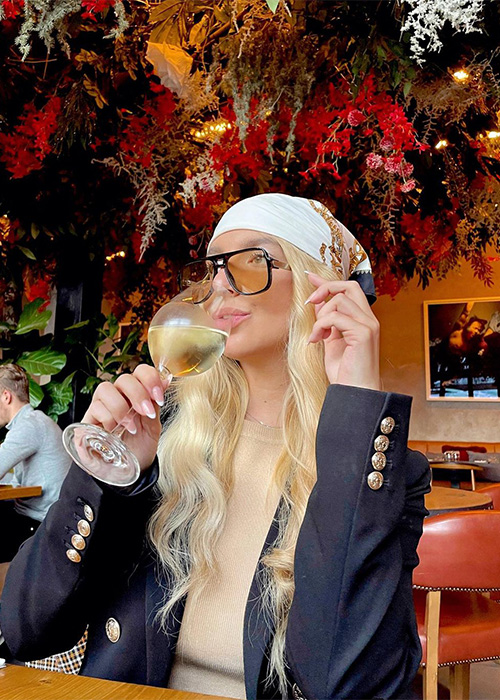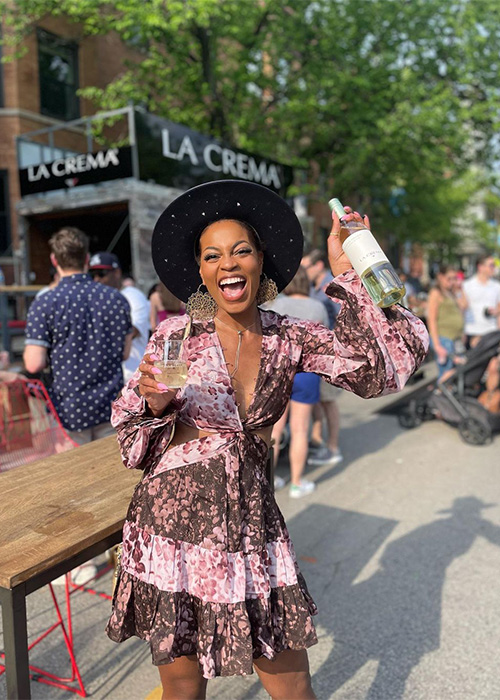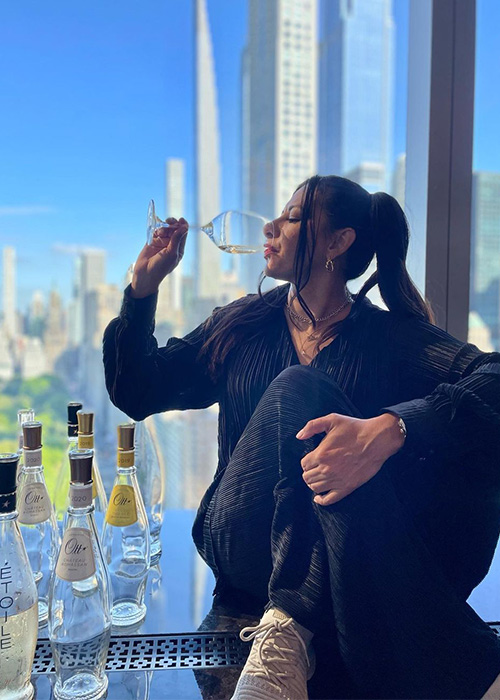Wine has always been synonymous with a “particular” type of crowd. One that is affluent, older, mostly male, and mostly white. That narrative is beginning to shift, though, thanks in part to social media and the rise of the “wine influencer.”
Around 2010, influencer marketing became an increasingly important strategy for brands hoping to connect with consumers via social media. So important has the role of an influencer become that in 2019 the term was officially recognized by Merriam-Webster dictionary as a career. From the outside looking in, the life of an influencer seems the perfect role for creatively driven millennials. But what does that role look like when wine enters the equation?
Following the life of a wine influencer on Instagram affords a gaze into a world of press packages, glamorous trips, and fancy events where the wine flows freely. But behind those scenes, these social media stars say, is a tale of long hours, hard work, and often limited earnings.
Don’t Miss A Drop
Get the latest in beer, wine, and cocktail culture sent straight to your inbox.
The Importance of Influencer Marketing
In industries such as fashion and beauty, influencers have proven to be so advantageous that it has created new roles for publicists and brand marketers. Today these jobs require knowledge of the influencer landscape social media platforms in order to connect brands with the right type of influencer.
As with all influencer relationships, the best and most profitable partnerships are organic and authentic, says Sally Alfis, senior vice president of lifestyle, spirits, and wine at NYC-based creative agency M Booth. “Both brands and influencers have become much savvier to the idea of being more invested in each other in order to create content that isn’t forced.”
Numerous findings have shown the disconnect between legacy wine brands and a growing younger consumer base. This is where influencer marketing can be an effective tool for both established and newer brands.
Influencers provide a network and an audience that brands may not be able to reach on their own. They are a marketing tool whose benefit continues to grow, with social media being so central to the way we live today.
According to Alfis, many brands want to utilize influencers but the investment can prove too costly, especially for smaller brands. But the brands that are fiscally able and willing to let influencers tell their stories are seeing impactful returns on their investments. “They are a crucial mechanism for advocacy, especially in the digital earmarking culture we live in today,” says Alfis.
With the role blossoming into a lucrative and alluring career path, VinePair spoke with three woman to find out what it really means to be a wine influencer.
Kimberlee Lizakowski, @ThatBlondeWino

What does being a wine influencer mean to you?
Wine can be intimidating, especially for young adults. There is the stigma attached to wine — that it is mainly to be enjoyed and understood by older wealthier adults. So, when I started “That Blonde Wino,” I wanted to create an account that shared useful wine information in an approachable manner that reaches the “everyday” wine drinker.
How has the brand and marketing side of wine adjusted to wine influencers?
Influencer marketing is quite new to the wine space so it is still something a lot of brands are learning about and putting into action. Social media is such an effective tool for these brands to gain exposure and a presence online.
Working with influencers who have an established and loyal following can quickly and effectively benefit the brand. As Generation Z individuals are beginning to reach legal drinking age, wine brands need to realize that this age group that is now a potential wine consumer has grown up with social media. In short, they need to evolve and realize the value we as influencers provide.
What does your schedule typically look like?
At this moment, “That Blonde Wino” is my side hustle so I still have a full-time job as a social media manager. It makes for a very busy schedule as influencer marketing is a full-time job in itself. Organization is key, so I keep a social calendar to keep track of ongoing campaigns and deadlines.
Living in New York I’m lucky to attend a lot of brand events and often I’m getting ready at my office to head straight from work. I try to attend events during the week so I can reserve the weekends for shooting and creating content.
Who’s your target audience and how do you keep them engaged?
My target audience is anyone who loves wine, fashion, and NYC content. I aim to keep my page fun and post things like wine and shoe pairings, which brings together my two passions: wine and fashion.
Isis Daniel, @TheMillennialSomm

How did you first get into wine and when did you begin influencing?
In 2018, Maia Parish (Master of Wine) reached out and encouraged me to take my first wine course at Capital Wine School. From there I began using social media as a way to help me study for my WSET journey.
My goal as an influencer has never been to convince people to drink sponsored wine or to take great pictures; it’s to help people understand their palates and to ignite their curiosity about wine.
What does your relationship with brands look like?
It’s important that their goals and image align with my overall content. I taste all the wines before agreeing to work with a particular brand. If I approve, we discuss their needs and how we can best collaborate. It’s crucial that the content must be authentic, fun, and in my voice.
How has the brand and marketing side of wine adjusted to wine influencers?
Personally, I haven’t seen the marketing space shift. I’ve seen influencers create their own path into other markets. However, the wine industry still struggles to invest, value, and appropriately utilize social media and influencers’ impact.
What has your experience been as a woman of color in the wine influencer space?
Although I am still a minority in most wine spaces and fighting for my respect, my experience as a Black woman in the wine industry has been a dream. I’m grateful for all the women who walked this path before me and, in time, I plan to shake the very foundation of this industry.
To date, I broke the record of the highest white wine sold at the Sonoma Barrel Auction, have been included in a prominent 40 under 40 tastemaker list, and was mentioned as a leader in the wine industry at Burgundy School of Business. I truly feel like my story as a Black woman and wine influencer has only just begun.
Elle Rodriguez, @TheModernPour

What type of wine drinker do you create content for?
My viewership is pretty balanced across the board. Wine is no longer just for the rich and the upper class. There’s a price point for every single person. I try to hit those price points for what best suits my followers. Most of the wines I promote are under $35 and, from what I’ve seen, there’s a larger market for under $30 rather than over. The old way of thinking is the more you spend, the better the wine, but that’s not always the case.
What does a typical day for you look like?
With my background in media and marketing, I’ve been a full-time “wine influencer” going on five years now. I think from the outside it looks easy, but it can be quite demanding. A typical day for me starts off early with an iced vanilla latte and a quick scroll through social media for ideas and to get my creative juices flowing.
By 9 a.m. I’m posting my first reels and typically around noon I record some un-boxings. At 2 p.m. I post my second reels. I think it’s important to post those twice a day to hit the analytics on social media. Then after 5 p.m., I’m off to an event or a dinner to create more content. I recently had one of my [Instagram] reels go viral, so right now I’m putting a lot more energy into them and TikTok.
Throughout the years, I’ve learned to curate my life to be flexible because this isn’t a 9-to-5 job. It’s a lifestyle that requires work seven days a week and my routine doesn’t slow down when I’m on the road traveling.
Has the influencer/brand relationship evolved?
When I started, being an influencer meant shots sitting in the vineyard sipping wine amongst a bland, rigid crowd. Today, influencer marketing is very crucial to marketers. Brands need more than just one blog post, and they have to invest in a real relationship with their influencers in order for the content to be authentic. I have some very long-standing relationships with brands and winemakers because they’ve taken the time to do that and it’s paid off for them.
Is the world of wine ready for the full-time influencer?
Absolutely! The wine industry is a multi-billion dollar industry with huge competition, very similar to fashion and beauty, which thrives on full-time influencers. As a Latina in wine industry, I feel like I have to work twice as hard to get the same respect from my peers and my colleagues.
I’ve been doing this a long time with over 850 posts and I’ve had to deal with a lot of rejection, but I’m finally getting to the point that I’m confident and successful and it empowers me.
I’ve worked with some of the largest PR companies in the industry and have been featured on tons of collaborations. Still, I’m barely getting a seat at the table. My seat is more of a fold-up chair that I brought from home. Nonetheless, I’m driven to change the industry for myself and other POC in this space. I’m 5-3, but my voice makes me 6-3.


